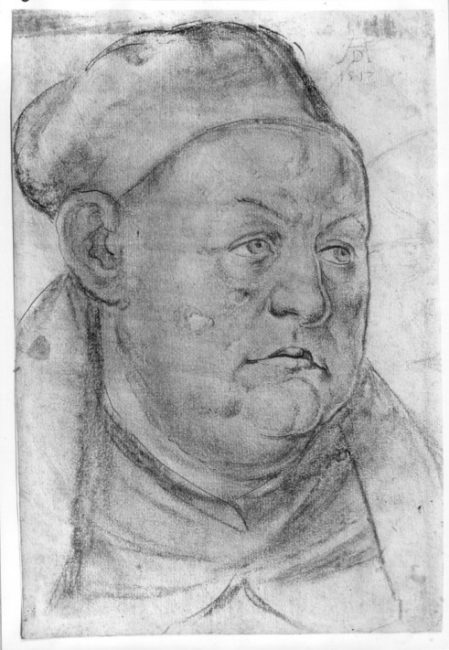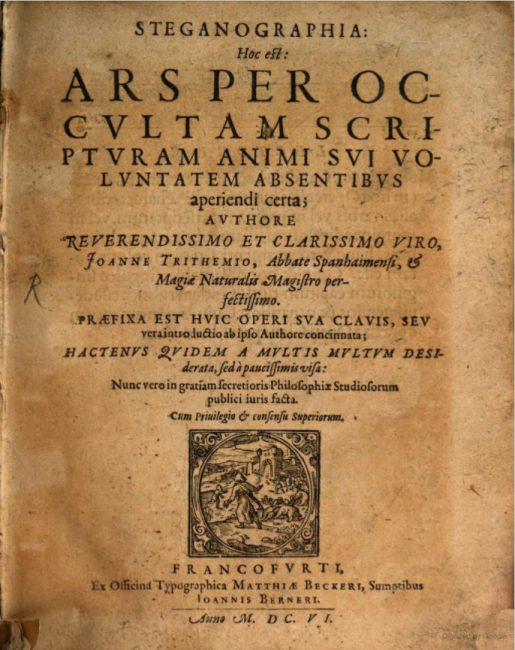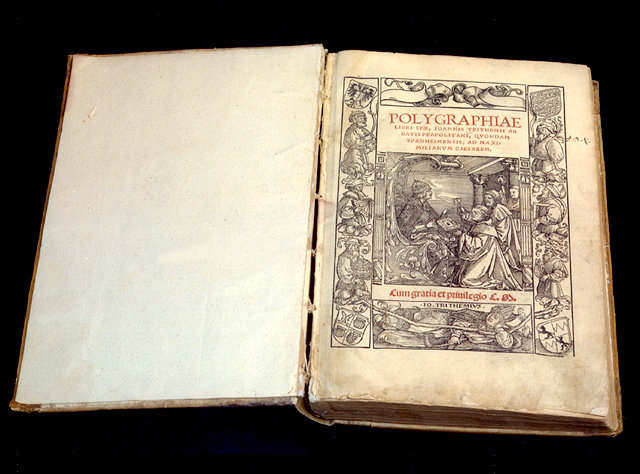
Johannes Trithemius (1462-1516), drawing by Albrecht Dürer (1517)
On February 1, 1462, German Benedictine abbot and polymath Johannes Trithemius was born. Trithemius was active in the German Renaissance as a lexicographer, chronicler, cryptographer, and occultist. He had considerable influence on the development of early modern cryptography and modern occultism. However,
“Speak of things public to the public, but of things lofty and secret only to the loftiest and most private of your friends. Hay to the ox and sugar to the parrot.”
― Johannes Trithemius
Johannes Trithemius – Youth and Education
Johannes Trithemius, latinized from Johann(es) Tritheim, also called Johannes von Trittenheim, Johann Heidenberg and Johannes Zeller, was born in Trittenheim on the Moselle River, at the time part of the Electorate of Trier. Before he was one year old, his father, Johann von Heidenburg, died. His stepfather, whom his mother Elisabeth married seven years later, was an opponent of education and put numerous obstacles in the way of young Trithemius. Only in secret and with great difficulty could he learn Greek and Latin, and later Hebrew. At the age of 17 he fled from his parents’ house and went in search of outstanding teachers. In the process, he travelled via Trier, Cologne, the Netherlands and Heidelberg and, at the end of January 1482, he entered the Benedictine Abbey in Sponheim near Bad Kreuznach. On 29 July 1483, only one and a half years after joining the monastery, he was elected as the youngest member of the convent to become the 25th abbot of the monastery. On 9 November he received Benediction through the auxiliary bishop of Mainz, Berthold von Oberg.
An Abbot of 21 Years of Age
Trithemius emphatically eliminated the hitherto easygoing habits of the monks and brought a new seriousness to monastic life through numerous theological and educational activities. Through these disciplinary measures and a new regulation of the monastery rights, he also succeeded in consolidating the economic situation of the run-down finances. In 1491, a register of the monastery’s possessions was compiled on his behalf, and he also had two “Weisthümer”, i.e. historical legal texts, created. His unusual activity and assertiveness did not go unnoticed for long. Soon he was appointed as Visitor of the surrounding sister monasteries and finally as Co-President of the General Chapter of the Congregation of Bursfeld.
The Largest Library of Germany
In the exercise of his official duties and as a sought-after preacher and speaker, Trithemius travelled to large parts of Germany, much to the benefit of his great passion, the library of the monastery. When he entered the monastery, there were 48 books there, which was the usual number for a monastery library at that time. By 1505, when Trithemius left Sponheim, the stock had grown to more than 2000 copies, one of the largest, if not the largest library in Germany. Most of the monastery’s income was spent on it. The fame of this treasure of knowledge radiated throughout Europe, making Trithemius famous and attracting a large stream of learned visitors to Sponheim. Besides the leading humanists of his time, Johan Reuchlin, Conrad Celtis,[1] Johann XX. von Dalberg, Dietrich Gresemund or Jakob Wimpheling, he was in contact with bishops, electors and even Emperor Maximilian I. The Emperor commissioned him to conduct a genealogical study of the Habsburg dynasty.
Trithemius’ Work
Trithemius is considered one of the most versatile and important German scholarly personalities of his time, even though he had never attended a university. In addition to his active lecturing activities, he was a sought-after teacher and advisor in intellectual and courtly circles. His friends Johan Reuchlin and Conrad Celtis praised his erudition. Alexander Hegius reported on his visit with the words: “I have seen the great, shining light of the world“. The young Elector Joachim I of Brandenburg called Trithemius the “splendour of our age“. For more than 20 years of his life Trithemius dealt with languages and secret languages; these interests found their most lasting expression in two cryptological works: first in Steganographia (1499/1500), conceived in two versions and not published by the author, and then in Polygraphia (1508/1515), repeatedly revised.
Steganographia
Trithemius’ most famous work, Steganographia (written c. 1499; published Frankfurt, 1606)[7], was placed on the Index Librorum Prohibitorum in 1609 [2] and removed in 1900. This book is in three volumes, and appears to be about magic — specifically, about using spirits to communicate over long distances. Since the publication of the decryption key to the first two volumes in 1606, they have been known to be actually concerned with cryptography and steganography, the later means the art of concealing a message within another message. Until recently, the third volume was widely still believed to be solely about magic, but the “magical” formulae have now been shown to be covertexts for yet more cryptographic content.[6] However, mentions of the magical work within the third book by such figures as Agrippa and John Dee still lend credence to the idea of a mystic-magical foundation concerning the third volume.[3]

Trithemius, Johannes. Steganographia, first published 1606, written c. 1499
Additionally, while Trithemius’s steganographic methods can be established to be free of the need for angelic–astrological mediation, still left intact is an underlying theological motive for their contrivance. The preface to the Polygraphia equally establishes, the everyday practicability of cryptography was conceived by Trithemius as a “secular consequent of the ability of a soul specially empowered by God to reach, by magical means, from earth to Heaven“. Robert Hooke [4] suggested in the chapter Of Dr. Dee’s Book of Spirits, that John Dee made use of Trithemian steganography, to conceal his communication with Queen Elizabeth I.[5] Amongst the codes used in this book is the Ave Maria cipher where each coded letter is replaced by a short sentence about Jesus in latin.

Johannes Trithemius, Polygraphiae (1518)
Controversies
About the misunderstood Steganographia, which was not explained to his visitor Bo[u]velles, Trithemius was suspected of black magic since 1503. In the Antipalus maleficiorum (‘enemies of witchcraft‘), Trithemius turned against alleged sorcerers and witches. The tireless bibliographer also compiled a detailed list of theologically “permitted” and “forbidden” writings. In De septem secund[da]eis (‘Of the seven [helper] spirits‘) Trithemius reported a third time about the planetary spirits that first appeared in Steganographia III, then also in Polygraphia, who ruled the world on God’s behalf, and ended this digression with a cautious “Whoever believes these things…“.
Later Life
The numerous high-ranking guests brought unrest and extensive work for the monks. Trithemius saw himself as a monastic reformer who was concerned about a stricter agenda, more fasting days and monastic discipline. There was increasing tension between the abbot and the monastery. In 1506, Trithemius found a new home in the Scottish monastery of St. Jacob in Würzburg at the call of Prince Bishop Lorenz von Bibra, who was open to humanistic ideas. There he was elected abbot in the same year; he held this position until his death in 1516. In St. Jacob’s he was highly esteemed for his learnedness, but the loss of his library overshadowed and embittered his old age. He was buried in the Scottish monastery in Würzburg (from 1825 Collegiate Monastery Neumünster). His epitaph, which shows him in a pontifical robe with mitre and staff, is from Tilman Riemenschneider’s school. Notably, the German polymath, physician, legal scholar, soldier, theologian, and occult writer Heinrich Cornelius Agrippa (1486–1535) and the Swiss physician, alchemist, and astrologer Paracelsus (1493–1541) were among his pupils.[12]
Christoph Paar, Lecture 1: Introduction to Cryptography, [14]
References and Further Reading:
- [1] Conrad Celtis, the first Poeta Laureata, SciHi Blog
- [2] Index Librorum Prohibitorum – The List of Banned Books, SciHi Blog
- [3] John Dee and his World of Science and Magic, SciHI Blog
- [4] Robert Hooke and his Famous Observations of the Micrographia, SciHi Blog
- [5] The Virgin Queen – Elizabeth I., SciHi Blog
- [6] Reeds, Jim (1998). “Solved: The ciphers in book III of Trithemius’s Steganographia“. Cryptologia. 22 (4): 191–317. doi:10.1080/0161-119891886948.
- [7] Steganographia in english (Trithemius.com)
- [8] Polygraphiae libri sex Ioannis Trithemij George Fabyan Collection at the Library of Congress
- [9] Works by or about Johannes Trithemius at Internet Archive
- [10] Herbermann, Charles, ed. (1913). . Catholic Encyclopedia. New York: Robert Appleton Company.
- [11] Chisholm, Hugh, ed. (1911). . Encyclopædia Britannica. 27 (11th ed.). Cambridge University Press.
- [12] Paracelsus – a Typical Renaissance Scientist?, SciHi Blog
- [13] Johannes Trithemius at Wikidata
- [14] Christoph Paar, Lecture 1: Introduction to Cryptography @ youtube
- [15] Timeline of Cryptography, via DBpedia and Wikidata






Pingback: 10 Incredible Ancient Codes – Toptenz.net – BuzzingTrends